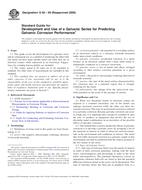Wir benötigen Ihre Einwilligung zur Verwendung der einzelnen Daten, damit Sie unter anderem Informationen zu Ihren Interessen einsehen können. Klicken Sie auf "OK", um Ihre Zustimmung zu erteilen.
ASTM G82-98(2009)
Standard Guide for Development and Use of a Galvanic Series for Predicting Galvanic Corrosion Performance
Automatische name übersetzung:
Standard-Leitfaden für Entwicklung und Verwendung eines galvanischen Reihe für Vorhersage Galvanische Korrosion Leistung
NORM herausgegeben am 1.5.2009
Informationen über die Norm:
Bezeichnung normen: ASTM G82-98(2009)
Anmerkung: UNGÜLTIG
Ausgabedatum normen: 1.5.2009
SKU: NS-57839
Zahl der Seiten: 7
Gewicht ca.: 21 g (0.05 Pfund)
Land: Amerikanische technische Norm
Kategorie: Technische Normen ASTM
Die Annotation des Normtextes ASTM G82-98(2009) :
Keywords:
active, corrosion potential, galvanic corrosion, Galvanic Series, noble, passive, Accelerated aging/testing--corrosion, Aluminum, Aluminum alloys--corrosion testing, Austenitic steel, Brass, Bronze, Cadmium metals/alloys, Conductance and conductivity (electrical), Copper corrosion, Electrical contact materials, Electrolytic conductivity detectors (ELCD), Galvanic corrosion, Heavy metals, Lead metals/alloys, Magnesium, Magnesium alloys, Metallurgical materials/applications
Ergänzende Informationen
| Significance and Use | |||||||||||||||||||||||||||||||||||||||||||||||||||||||||||||||||||||||||||||||||||||||||||||||||||||||
|
When two dissimilar metals in electrical contact are exposed to a common electrolyte, one of the metals can undergo increased corrosion while the other can show decreased corrosion. This type of accelerated corrosion is referred to as galvanic corrosion. Because galvanic corrosion can occur at a high rate, it is important that a means be available to alert the user of products or equipment that involve the use of dissimilar metal combinations in an electrolyte of the possible effects of galvanic corrosion. One method that is used to predict the effects of galvanic corrosion is to develop a galvanic series by arranging a list of the materials of interest in order of observed corrosion potentials in the environment and conditions of interest. The metal that will suffer increased corrosion in a galvanic couple in that environment can then be predicted from the relative position of the two metals in the series. Types of Galvanic Series: Oe type of Galvanic Series lists the metals of interest in order of their corrosion potentials, starting with the most active (electronegative) and proceeding in order to the most noble (electropositive). The potentials themselves (versus an appropriate reference half-cell) are listed so that the potential difference between metals in the series can be determined. This type of Galvanic Series has been put in graphical form as a series of bars displaying the range of potentials exhibited by the metal listed opposite each bar. Such a series is illustrated in Fig. 1. The second type of galvanic series is similar to the first in that it lists the metals of interest in order of their corrosion potentials. The actual potentials themselves are not specified, however. Thus, only the relative position of materials in the series is known and not the magnitude of their potential difference. Such a series is shown in Fig. 2. Use of a Galvanic Series: Generally, upon coupling two metals in the Galvanic Series, the more active (electronegative) metal will have a tendency to undergo increased corrosion while the more noble (electropositive) metal will have a tendency to undergo reduced corrosion. Usually, the further apart two metals are in the series, and thus the greater the potential difference between them, the greater is the driving force for galvanic corrosion. All other factors being equal, and subject to the precautions in Section 5, this increased driving force frequently, although not always, results in a greater degree of galvanic corrosion. Note—Dark boxes indicate active behavior of active-passive alloys. FIG. 1 Galvanic Series of Various Metals in Flowing Seawater at 2.4 to 4.0 m/s for 5 to 15 Days at 5 to 30°C (Redrawn from Original) (see Footnote 5) ¦
|
|||||||||||||||||||||||||||||||||||||||||||||||||||||||||||||||||||||||||||||||||||||||||||||||||||||||
| 1. Scope | |||||||||||||||||||||||||||||||||||||||||||||||||||||||||||||||||||||||||||||||||||||||||||||||||||||||
|
1.1 This guide covers the development of a galvanic series and its subsequent use as a method of predicting the effect that one metal can have upon another metal can when they are in electrical contact while immersed in an electrolyte. Suggestions for avoiding known pitfalls are included. 1.2 The values stated in SI units are to be regarded as standard. No other units of measurement are included in this standard. 1.3 This standard does not purport to address all of the safety concerns, if any, associated with its use. It is the responsibility of the user of this standard to establish appropriate safety and health practices and determine the applicability of regulatory limitations prior to use. Specific precautionary statements are given in Section 5. |
|||||||||||||||||||||||||||||||||||||||||||||||||||||||||||||||||||||||||||||||||||||||||||||||||||||||
| 2. Referenced Documents | |||||||||||||||||||||||||||||||||||||||||||||||||||||||||||||||||||||||||||||||||||||||||||||||||||||||
|
Empfehlungen:
Aktualisierung der technischen Normen
Wollen Sie sich sicher sein, dass Sie nur die gültigen technischen Normen verwenden?
Wir bieten Ihnen eine Lösung, die Ihnen eine Monatsübersicht über die Aktualität der von Ihnen angewandten Normen sicher stellt.
Brauchen Sie mehr Informationen? Sehen Sie sich diese Seite an.




 Cookies
Cookies
